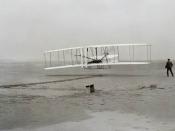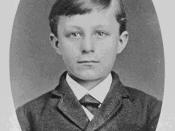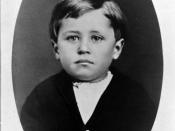� PAGE \* MERGEFORMAT �16�
Since ancient times, people have dreamed of flying. In Greek myths, heroes made wings to fly. The ancient Chinese invented kites and some reportedly carried humans aloft. During the middle ages, many people tried to fly. Some strapped on wings of cloth or feathers and jumped off towers or cliffs, yet nothing worked and many died.� Then in 1783, two French brothers, Joseph and Etienne Montgolfier, invented the hot air balloon. They filled a large cloth and paper bag with hot air from a fire. The hot air made the balloon lighter than the outside air and it rose over Paris, carrying the two noblemen. This was the first recorded human flight. In 1804, Englishman George Caley invented the first heavier-than-air craft, a model glider. Later piloted by Otto Lilienthal, Caley's gliders were the ancestors of the modern airplane.�
Throughout the 1800s there were many attempts at controlled flight; however, flight was not controlled until 1903.
Conditions were perfect for the Wright brothers to fly on the morning of December 17, 1903. The wind was blowing around twenty five miles per hour and the temperature was close to freezing, 34ÃÂF, which, when combined, created a low density altitude.� This increased the effectiveness of the wings and the propellers. At 10:30 a.m. Orville Wright climbed into the pilot's position next to the roaring engine and released the restraining wire that held the airplane in place. Slowly gaining speed against the strong headwind, the airplane clattered down the rail and into the air, flying 120 feet and touching the sand 12 seconds after takeoff. The brothers and their helpers carried the machine back to the starting point, and at 11:20 a.m. Wilbur took his position on the plane and made a flight of 175 feet in 12...


